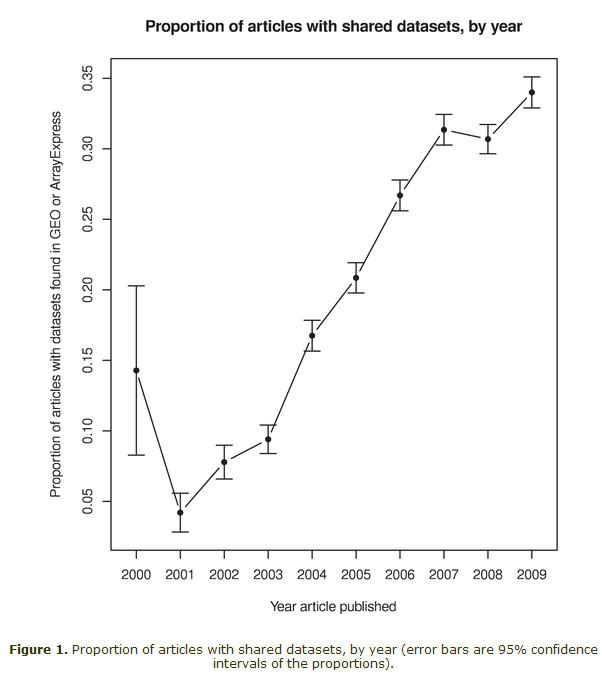Science 2.0 fave Heather A. Piwowar from the Department of Biomedical Informatics at Pitt recently gave it a shot, and the answer was...it's unknown.
In many aspects of science, sharing data is counter-productive to competition. If you publicize a failure, for example, you save a competitor a road you had to go down but if you share raw data of a success, it allows a competitor to quickly catch up. The one area where competitive issues do not seem to be an issue is genetics, so Piwowar looked over a decade of gene expression microarray datasets to see who made the 'raw data' available after publication.
She found that an impressive 45% of recent gene expression studies made the data available, a big improvement over 5% a decade ago when things like the Gene Expression Omnibus were started though, to be fair, methods then were clunky enough to only be used by real advocates.
Some results were expected; NIH-funded people shared results but Congressional law mandates access to NIH-funded studies and people who had shared data before, or used open access/pay-to-publish journals (peer reviewed or not) were more likely to share data.

Proportion of articles with shared datasets, by year (error bars are 95% confidence intervals of the proportions. doi:10.1371/journal.pone.0018657
Obviously it will get better - the NIH publishing requirements have been successful enough (and have not been blocked, despite the efforts of Democrats to protect big media journal campaign contributors) that more access is likely. The National Science Foundation now at least requires a data sharing plan in its Grant Proposal Guide and the benefit in microarray data seems to be obvious to the community because of the need for reproducibility.
In other areas, it is entirely possible that sharing data in open science fashion is being done, just among smaller networks and not the overall science community.
It's not going to happen immediately and a more heavy-handed approach would likely do more harm than good but this shows that open science is gaining acceptance. Old ways die hard.
Citation: Piwowar HA (2011) Who Shares? Who Doesn't? Factors Associated with Openly Archiving Raw Research Data. PLoS ONE 6(7): e18657. doi:10.1371/journal.pone.0018657





Comments